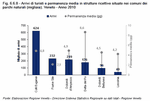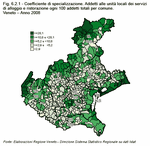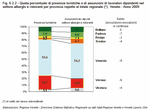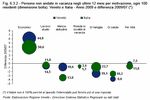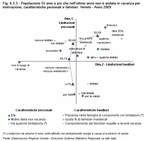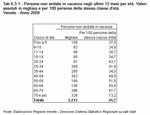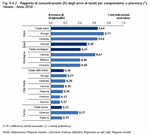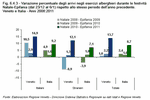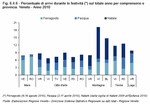-
Statistical department’s site
Home page
Our publications
Chapter 6
Tourism and culture
European policy on tourism, as outlined by the European Commission in the communication "Europe 2020" (Note 1), aims firstly to stimulate competition without losing touch with the close link between industry development and sustainability.
Back in 2006 the Commission had already adopted a renewed policy for the sector (Note 2), with the main aim of contributing to "improving the competitiveness of the European tourism industry and creating more and better jobs through the sustainable growth of tourism in Europe and globally". As well as growth and employment, social and environmental objectives are promoted. Sustainability in tourism (Note 3) concerns several aspects, such as the responsible use of natural resources; taking account of the environmental impact of activities (production of waste, pressure on water, land and biodiversity, etc.); the use of 'clean' energy, protection of the heritage and preservation of the natural and cultural integrity of destinations, the quality of customer care."
There is an apparent contrast between increased concern for these aspects and the development of competitive economic activity if limited to the present day. However, in a long term perspective there is an inextricable link, a balance between economic development and the protection of tourist destinations, to be reached thanks to integrated political strategies.
As seen in the Commission's communication, which is an Agenda for a sustainable and competitive European tourism (Note 4), "the future of European tourism is based on the quality of tourists' experience" and it is to maintain its competitiveness that the tourism sector is turning towards sustainability. The Agenda is part of the implementation phase of the renewed Lisbon Strategy for growth and employment and the renewed Strategy for sustainable development. It places emphasis on making tourism available to everyone without discrimination, on reducing the seasonal effects on demand, and on improving the quality of jobs. Following an analysis of the economic situation, attention will be focused on these latter aspects.
Regione Veneto has set in motion policies that are in line with the rest of Italy and with Europe. It has adopted the Regional plan for the development of sustainable and competitive tourism, giving incentives to local authorities and accommodation establishments that an acquire environmental certification. It has also adhered to numerous projects for the promotion and development of sustainable, responsible and high-quality tourism (Note 5). It is also the pilot region for the experimentation of sustainable tourism practices in Europe.
Back in 2006 the Commission had already adopted a renewed policy for the sector (Note 2), with the main aim of contributing to "improving the competitiveness of the European tourism industry and creating more and better jobs through the sustainable growth of tourism in Europe and globally". As well as growth and employment, social and environmental objectives are promoted. Sustainability in tourism (Note 3) concerns several aspects, such as the responsible use of natural resources; taking account of the environmental impact of activities (production of waste, pressure on water, land and biodiversity, etc.); the use of 'clean' energy, protection of the heritage and preservation of the natural and cultural integrity of destinations, the quality of customer care."
There is an apparent contrast between increased concern for these aspects and the development of competitive economic activity if limited to the present day. However, in a long term perspective there is an inextricable link, a balance between economic development and the protection of tourist destinations, to be reached thanks to integrated political strategies.
As seen in the Commission's communication, which is an Agenda for a sustainable and competitive European tourism (Note 4), "the future of European tourism is based on the quality of tourists' experience" and it is to maintain its competitiveness that the tourism sector is turning towards sustainability. The Agenda is part of the implementation phase of the renewed Lisbon Strategy for growth and employment and the renewed Strategy for sustainable development. It places emphasis on making tourism available to everyone without discrimination, on reducing the seasonal effects on demand, and on improving the quality of jobs. Following an analysis of the economic situation, attention will be focused on these latter aspects.
Regione Veneto has set in motion policies that are in line with the rest of Italy and with Europe. It has adopted the Regional plan for the development of sustainable and competitive tourism, giving incentives to local authorities and accommodation establishments that an acquire environmental certification. It has also adhered to numerous projects for the promotion and development of sustainable, responsible and high-quality tourism (Note 5). It is also the pilot region for the experimentation of sustainable tourism practices in Europe.
The types of tourism offered by Veneto are unique, varied and high quality. In 2010 the number of tourists visiting the region was once again on the rise, a positive sign after the halt in development in the sector following the economic crisis which began at the end of 2008, one that affected the demand for tourist services at a European level. In the meantime the trends of tourists have changed: they prefer closer destinations, briefer holidays, saving on expenses once they arrive at their destination. In 2010 there were over 14.5 million tourists, up 600,000 on the previous year (+4.6%). The recovery corresponds to a smaller increase in the number of nights spent (+0.6%), reaching over 60.8 million, revealing a reduction in the average number of nights spent in holiday destinations (4.2 days). (Figure 6.1.1) and (Table 6.1.1).
Thanks to the millions of tourists who choose Veneto for their holidays, it has been the leading tourist region in Italy for quite a few years now. This continued into 2009, the last year for which national data are available, with 14.6% of arrivals and 16.3% of nights spent in the entire country. No other region in Italy can offer such a complete holiday experience, satisfying every request in the best possible way. Just think that within a few kilometres Veneto can offer its visitors a holiday by the sea, in the mountains (which have become a World Heritage site), or in natural parks, in the hills, by a lake, at a spa resort, and in unique historic cities; numerous cultural, theatrical and sporting events are also offered, all enriched by an excellent culinary tradition. (Figure 6.1.2)
It should be noted that the survey that this analysis is part of reveals information only about those who spend at least one night in the region, that is in accommodation establishments for reasons which may include holiday, business, well-being, health treatment, sport, religion, etc. These figures therefore do not take into account same-day visitors drawn by important events and exhibitions. Although they cannot be quantified, they are a significant phenomenon for the region's economy.
The table of Italian visitors remains largely unchanged with a 9% difference between the number of visitors resident in Veneto and those resident in Lombardia; after which come Lazio, Emilia Romagna, Trentino, Alto Adige, Piemonte, etc. (Table 6.1.3)
Last year, the only destinations that saw an increase in both international and Italian visitors were the historic cities. There was an increase in the number of Italian visitors to the spa resorts, while foreign tourists to Lago di Garda, where a large proportion of clients already go (80.7%), and to mountain resorts also increased. Fewer Italians, in particular, go to seaside resorts, while the number of international visitors is essentially stable (-0.5%). (Figure 6.1.3)
Summing up for 2010, Veneto's famous historic cities made a good recovery although they had been hit by the greatest difficulties in 2009; they recovered the sharp upward trend seen in previous years (+9.8% of arrivals and +4.5% of nights spent). There was an increase in nights spent by Veneto's most faithful visitors, Americans (+4%) and French (+3.8%), but also by Veneto residents themselves (+11.7%).
On the other hand, seaside holidays, which in recent years had managed to maintain the number of visitors at both a national and international level, are the only area to have seen a slowdown in the growth of tourist numbers in terms of both arrivals and nights spent. However, adverse weather conditions in June, marking the start of the beach season, could be to blame. This was followed by a period of unstable weather over the mid-August holiday in 2010. The most significant decrease concerns Veneto residents and German holidaymakers.
Holidays spent by Lago di Garda continue to show signs of success, with a rise of +2.9% for both arrivals and nights spent.
Mountain and spa resorts also share a rising number of tourists. However, on average, these tourists stay for a shorter period, a trend that is increasingly common, but which in this case leads to a fall in the number of nights spent. (Figure 6.1.5)
The stability of the tourism sector in terms of overnight stays is supported by the good year for the hotel sector (+2%), compared to slight losses for other types of accommodation (-0.5%), a turnaround in the situation for the two previous years. In the hotel sector there has been a strong recovery in the number of nights spent by international visitors, although the pre-recession figures have not been reached. The number of Italian visitors has continued to increase. (Figure 6.1.7)
Over the last decade there has been a decrease in the use of lower quality hotels, whilst the number of people staying in top hotels has increased. This trend has become more apparent since 2008, when there was initially a decrease for all categories followed by a recovery that only applied to the 4- and 5-star hotels. It would appear that the economic crisis is selective and that only high quality hotels have continued to find customers, extending their clientele towards new markets. The increase in the demand for high quality accommodation is accompanied by a corresponding supply, which is partly due to re-classification processes. In just one year the number of 4- and 5-star hotels increased by 23 establishments and over 3,900 bed places. (Table 6.1.4)
In 2008 there were 1,222 agrotourism establishments in Veneto, making up 6.6% of the national total. This share is lower only than the two regions in which historically this kind of holiday is deeply rooted: Toscana (21.3%) and Trentino Alto Adige (16.8%). Each agrotourism can have more than one licence, which means that Veneto establishments offer a varied combination of services. Accommodation and catering are the main activities, offered by 58% and 56.6% of agrotourisms respectively in 2009. In 43.9% of cases, basic products such as milk or fruit and/or products that go through some form of processing such as oil, wine and cheese, can be tasted as part of additional or alternative services.
Overall, the province of Verona has the highest number of agrotourism establishments in Veneto (24.2%). As concerns the three main licences, Verona is still the province with the highest number of establishments offering accommodation, but for catering and tasting, the province of Treviso has the highest number, followed by the province of Vicenza. (Figure 6.1.8)
In almost half of the establishments, services are specialised (47.1%) and, more precisely, 24.4% only offer accommodation, 13.6% only catering and 9% only tasting. Alongside these are many farmhouse establishments which offer several services, 13.6% offer a complete range of services of accommodation/catering/tasting. (Figure 6.1.9)
At national and regional level, tourism is also a major part of Italy's economy and it can be a driving force behind many other areas based in the tertiary sector. Forecasts for the economic value of tourism from international visitors have been provided by a survey conducted by the Bank of Italy (Note 10): with almost 24 billion euro of revenue in Italy from spending by international visitors alone in 2010, tourism can well be defined as an exceptional resource. Tourism is an industry that generates economic wealth from a cultural and natural patrimony of unquantifiable value.
Closer territorial analysis of 2010 reveals that spending (Note 11) by international visitors to Veneto was 3.9 billion euro-16.5% of spending by international visitors in Italy-a figure that makes Veneto Italy's second region after Lazio. Such a noteworthy result is reached thanks to the considerable number of tourists who come to Italy, 19.7% of whom come to Veneto, in first position in the Italian regional rankings. This constant flow of arrivals is combined with an equally impressive performance in terms of nights spent (18% of Italy's total). For about 80% of international tourists, the main reason for visiting Veneto is for a holiday; about 15% come for work; while the remaining 5% come for other personal reasons such as study, visiting friends and relatives, health treatment, etc. However, figures are lower for the average spending by tourists during their holiday: in Veneto spending per capita stands at around 385 euro compared with an Italian average of 457 euro. This figure is linked to the length of stay, which is one of the shortest when compared to other Italian regions (4.3 days compared with a national average of 4.7). In fact apart from the length of stay, the average daily spending by international tourists of around 90 euro per capita is much lower than that in Lazio (129 euro) and Lombardia (113 euro) for example, as well as lower than the national average (98 euro). (Figure 6.1.11)
If we look at spending abroad, people from Veneto spent 1,344 million euro, which ranks Veneto in fifth place with 8.3% of the national total.
The high revenues of incoming tourism and the more contained spending of outgoing tourism make Veneto Italy's leading region in terms of payment balance: 2,565 million euro in 2010.
If the expenditure of international tourism (revenue), that of Italians holidaying abroad (spending) and the tourist balance are taken as a percentage of GDP, we notice that Veneto's balance is much higher than Italy's. This is not so much due to spending, which is quite similar, as to revenue, which has much more of an influence on Veneto's economy than on Italy's in this sector. (Figure 6.1.12)
Value added within the hotel and restaurant sector should also be considered in order to highlight the overall economic importance of this sector, which is not simply bound to international tourism. This figure, which is only an approximate forecast of the value added for the entire tourism sector, was more than 6 billion euro in Veneto in 2007. It is 11.5% of the national total, a share that is second only to Lombardia.
The importance of value added within the hotel and restaurant sector for Veneto's entire economy is higher than the national level (4.6% compared with 3.8%).
Last year, despite the number of nights spent by international tourists being on the increase, a -1.5% drop in total income is estimated (Note 12). This is due principally to a decrease in the spending of Italian tourists and of Veneto residents in particular.
Precious input for the economy is provided by the turnover in the cruise ship sector, Venezia being one of the most important European ports. Italy is still the top European nation as concerns direct spending in the sector. Its 4.3 billion euro total for 2009 is way ahead of the United Kingdom (2.4 billion euro), the second European nation. And, despite the economic crisis, there has been a slight increase compared to 2008 (+0.3%), which bucks the downward trend for Europe (-1.2%).
Thanks to the millions of tourists who choose Veneto for their holidays, it has been the leading tourist region in Italy for quite a few years now. This continued into 2009, the last year for which national data are available, with 14.6% of arrivals and 16.3% of nights spent in the entire country. No other region in Italy can offer such a complete holiday experience, satisfying every request in the best possible way. Just think that within a few kilometres Veneto can offer its visitors a holiday by the sea, in the mountains (which have become a World Heritage site), or in natural parks, in the hills, by a lake, at a spa resort, and in unique historic cities; numerous cultural, theatrical and sporting events are also offered, all enriched by an excellent culinary tradition. (Figure 6.1.2)
It should be noted that the survey that this analysis is part of reveals information only about those who spend at least one night in the region, that is in accommodation establishments for reasons which may include holiday, business, well-being, health treatment, sport, religion, etc. These figures therefore do not take into account same-day visitors drawn by important events and exhibitions. Although they cannot be quantified, they are a significant phenomenon for the region's economy.
Origins of visitors
Tourism in Veneto is based mainly on a flow of international visitors: in 2010 international visitors accounted for 60.4% of the overall nights spent. International tourism has picked up, after a stagnant period in recent years, and today figures for international visitors are higher than those for Italian visitors (+2.3% compared with -1.8%). The countries of origin table reveals an increase in the nights spent by nationalities who have been the main visitors for many years: Germans (+0,5%), Austrians (+0,7%), French (+2,4%), Swiss (+3,4%), Danish (+2%) and Spanish (+1,9%). The number of Americans, which suffered an almost 10% decrease in 2009 owing to the effects of the global economic crisis, is beginning to increase (+1.7%). Moreover the number of Russians (+29%), Japanese (+4.9%) and Chinese (+25.3%) is continuing to rise and these nationalities find themselves in 14th, 15th and 17th place respectively. The Chinese and Japanese prefer visiting the historic cities, which record 94% of their nights spent. In particular Venezia, which is part of package holidays along with Firenze and Roma, continues to be a meeting point between Europe and China. Russian tourists stay mainly by the sea (45%) and in historic cities (42%), but there have been notable increases in the spa towns. (Table 6.1.2)The table of Italian visitors remains largely unchanged with a 9% difference between the number of visitors resident in Veneto and those resident in Lombardia; after which come Lazio, Emilia Romagna, Trentino, Alto Adige, Piemonte, etc. (Table 6.1.3)
Last year, the only destinations that saw an increase in both international and Italian visitors were the historic cities. There was an increase in the number of Italian visitors to the spa resorts, while foreign tourists to Lago di Garda, where a large proportion of clients already go (80.7%), and to mountain resorts also increased. Fewer Italians, in particular, go to seaside resorts, while the number of international visitors is essentially stable (-0.5%). (Figure 6.1.3)
Destinations
Veneto, which stands out for its culture of hospitality and the variety and quality of local tourism, has always been geared towards a demand which is constantly changing and requires constant renewal. As well as the traditional destinations, there is "alternative" tourism, whereby tourists discover places, villas or historic buildings, local traditions, craft products, food and wine. Tourism sectors that are seeing a sharp rise are those connected with sports holidays, such as cycling, motorbiking, golf, horseriding, but also with well-being, conference tourism, etc. (Figure 6.1.4).Summing up for 2010, Veneto's famous historic cities made a good recovery although they had been hit by the greatest difficulties in 2009; they recovered the sharp upward trend seen in previous years (+9.8% of arrivals and +4.5% of nights spent). There was an increase in nights spent by Veneto's most faithful visitors, Americans (+4%) and French (+3.8%), but also by Veneto residents themselves (+11.7%).
On the other hand, seaside holidays, which in recent years had managed to maintain the number of visitors at both a national and international level, are the only area to have seen a slowdown in the growth of tourist numbers in terms of both arrivals and nights spent. However, adverse weather conditions in June, marking the start of the beach season, could be to blame. This was followed by a period of unstable weather over the mid-August holiday in 2010. The most significant decrease concerns Veneto residents and German holidaymakers.
Holidays spent by Lago di Garda continue to show signs of success, with a rise of +2.9% for both arrivals and nights spent.
Mountain and spa resorts also share a rising number of tourists. However, on average, these tourists stay for a shorter period, a trend that is increasingly common, but which in this case leads to a fall in the number of nights spent. (Figure 6.1.5)
Choice of accommodation establishment
Tourists coming to Veneto can be divided between those who stay in hotels and those who stay in other establishments (Note 6). The trends are different to those for the rest of Italy and for Europe in general. In Veneto there are more overnight stays in other establishments than in hotels, and this is due above all to the number of tourists who visit seaside, lakeside and mountain resorts. In Veneto's historic cities, on the other hand, in 2010 the hotels welcomed almost 80% of the tourist flow and this is practically the only type of accommodation available in the spa towns. (Figure 6.1.6)The stability of the tourism sector in terms of overnight stays is supported by the good year for the hotel sector (+2%), compared to slight losses for other types of accommodation (-0.5%), a turnaround in the situation for the two previous years. In the hotel sector there has been a strong recovery in the number of nights spent by international visitors, although the pre-recession figures have not been reached. The number of Italian visitors has continued to increase. (Figure 6.1.7)
Over the last decade there has been a decrease in the use of lower quality hotels, whilst the number of people staying in top hotels has increased. This trend has become more apparent since 2008, when there was initially a decrease for all categories followed by a recovery that only applied to the 4- and 5-star hotels. It would appear that the economic crisis is selective and that only high quality hotels have continued to find customers, extending their clientele towards new markets. The increase in the demand for high quality accommodation is accompanied by a corresponding supply, which is partly due to re-classification processes. In just one year the number of 4- and 5-star hotels increased by 23 establishments and over 3,900 bed places. (Table 6.1.4)
Agrotourism
Apart from being surrounded by nature and getting away from the chaos of city life, guests are seduced by Veneto's food and wine, history, traditions and local community. In agrotourism establishments, as well as staying in a welcoming environment, guests can sample local products which reflect local gastronomic traditions.In 2008 there were 1,222 agrotourism establishments in Veneto, making up 6.6% of the national total. This share is lower only than the two regions in which historically this kind of holiday is deeply rooted: Toscana (21.3%) and Trentino Alto Adige (16.8%). Each agrotourism can have more than one licence, which means that Veneto establishments offer a varied combination of services. Accommodation and catering are the main activities, offered by 58% and 56.6% of agrotourisms respectively in 2009. In 43.9% of cases, basic products such as milk or fruit and/or products that go through some form of processing such as oil, wine and cheese, can be tasted as part of additional or alternative services.
Overall, the province of Verona has the highest number of agrotourism establishments in Veneto (24.2%). As concerns the three main licences, Verona is still the province with the highest number of establishments offering accommodation, but for catering and tasting, the province of Treviso has the highest number, followed by the province of Vicenza. (Figure 6.1.8)
In almost half of the establishments, services are specialised (47.1%) and, more precisely, 24.4% only offer accommodation, 13.6% only catering and 9% only tasting. Alongside these are many farmhouse establishments which offer several services, 13.6% offer a complete range of services of accommodation/catering/tasting. (Figure 6.1.9)
Wine and Typical Product Roads
For some time, Regione Veneto has been promoting local products through food and wine routes. Regional Law LR no. 17 of 2000 fosters and governs the creation of Wine and Typical Product Roads, which run through areas in which DOC (Note 7) and DOCG (Note 8) wines, as well as other food products of protected origin (DOP) and protected geographical status (IGP), are produced. The routes are associations whose members include public and private structures such as farms, agrotourisms, wine producers and wine cellars, hotels, restaurants and craft-type enterprises, and local bodies and associations. These sign-posted routes go through production areas and sites and offer tourists the opportunity to encounter the natural and cultural resources of the area they are visiting. Until now nineteen have been formally recognised, most of these in 2002, the last two in 2007. In the rest of Italy, Toscana is the only other region to have reached such a figure. Collaboration between various subjects leads to the promotion of an integrated local tourism that aims to become increasingly popular; it is based on food and wine tourism, which is no longer a niche category, but is becoming increasingly widespread and is not greatly influenced by the economy, income and consumption. One of many examples is how the huge success of agrotourism establishments in Veneto over the last four years (+68.3% of nights spent) has seen a steady flow of tourists in establishments along its Wine and Typical Product Roads. (Figure 6.1.10)The economic value of tourism
"Tourism is indeed one of the economic activities with most significant potential to generate future growth and employment in the EU. In its narrowest definition (hotels, restaurants, bars, travel agencies, car hire companies, airlines, etc.), tourism currently contributes some 4% to EU GDP, but its indirect contribution to GDP is much higher: tourism indirectly generates more than 10% of EU GDP and provides about 12% of all jobs. Tourism is particularly important when it comes to offering job opportunities to young people, who represent twice as much of the labour force in tourism than in the rest of the economy. Employment growth in the tourism sector has been significantly higher than in the rest of the economy in recent years, making the sector a significant contributor to the Lisbon objective to create more and better jobs." This introduction, from the European Commission Communication on the "Agenda for a sustainable and competitive European tourism" (Note 9), provides a summary of the economic value of tourism at a European level.At national and regional level, tourism is also a major part of Italy's economy and it can be a driving force behind many other areas based in the tertiary sector. Forecasts for the economic value of tourism from international visitors have been provided by a survey conducted by the Bank of Italy (Note 10): with almost 24 billion euro of revenue in Italy from spending by international visitors alone in 2010, tourism can well be defined as an exceptional resource. Tourism is an industry that generates economic wealth from a cultural and natural patrimony of unquantifiable value.
Closer territorial analysis of 2010 reveals that spending (Note 11) by international visitors to Veneto was 3.9 billion euro-16.5% of spending by international visitors in Italy-a figure that makes Veneto Italy's second region after Lazio. Such a noteworthy result is reached thanks to the considerable number of tourists who come to Italy, 19.7% of whom come to Veneto, in first position in the Italian regional rankings. This constant flow of arrivals is combined with an equally impressive performance in terms of nights spent (18% of Italy's total). For about 80% of international tourists, the main reason for visiting Veneto is for a holiday; about 15% come for work; while the remaining 5% come for other personal reasons such as study, visiting friends and relatives, health treatment, etc. However, figures are lower for the average spending by tourists during their holiday: in Veneto spending per capita stands at around 385 euro compared with an Italian average of 457 euro. This figure is linked to the length of stay, which is one of the shortest when compared to other Italian regions (4.3 days compared with a national average of 4.7). In fact apart from the length of stay, the average daily spending by international tourists of around 90 euro per capita is much lower than that in Lazio (129 euro) and Lombardia (113 euro) for example, as well as lower than the national average (98 euro). (Figure 6.1.11)
If we look at spending abroad, people from Veneto spent 1,344 million euro, which ranks Veneto in fifth place with 8.3% of the national total.
The high revenues of incoming tourism and the more contained spending of outgoing tourism make Veneto Italy's leading region in terms of payment balance: 2,565 million euro in 2010.
If the expenditure of international tourism (revenue), that of Italians holidaying abroad (spending) and the tourist balance are taken as a percentage of GDP, we notice that Veneto's balance is much higher than Italy's. This is not so much due to spending, which is quite similar, as to revenue, which has much more of an influence on Veneto's economy than on Italy's in this sector. (Figure 6.1.12)
Value added within the hotel and restaurant sector should also be considered in order to highlight the overall economic importance of this sector, which is not simply bound to international tourism. This figure, which is only an approximate forecast of the value added for the entire tourism sector, was more than 6 billion euro in Veneto in 2007. It is 11.5% of the national total, a share that is second only to Lombardia.
The importance of value added within the hotel and restaurant sector for Veneto's entire economy is higher than the national level (4.6% compared with 3.8%).
Last year, despite the number of nights spent by international tourists being on the increase, a -1.5% drop in total income is estimated (Note 12). This is due principally to a decrease in the spending of Italian tourists and of Veneto residents in particular.
Precious input for the economy is provided by the turnover in the cruise ship sector, Venezia being one of the most important European ports. Italy is still the top European nation as concerns direct spending in the sector. Its 4.3 billion euro total for 2009 is way ahead of the United Kingdom (2.4 billion euro), the second European nation. And, despite the economic crisis, there has been a slight increase compared to 2008 (+0.3%), which bucks the downward trend for Europe (-1.2%).
Figure 6.1.1
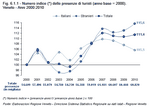
Table 6.1.1

Figure 6.1.2
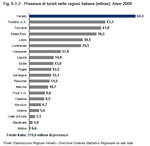
Table 6.1.2
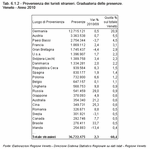
Table 6.1.3
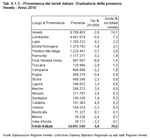
Figure 6.1.3

Figure 6.1.4
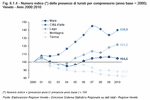
Figure 6.1.5

Figure 6.1.6
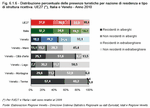
Figure 6.1.7
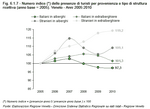
Table 6.1.4
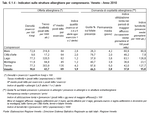
Figure 6.1.8
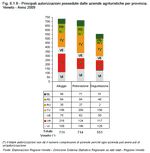
Figure 6.1.9

Figure 6.1.10
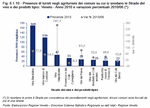
Figure 6.1.11
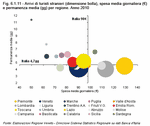
Figure 6.1.12

If Veneto has managed to remain the leading Italian region for the high flow of tourists for several years, it is also thanks to an impressive workforce. In 2008 the sector boasted 125,000 workers (Note 13). These numbers refer to local units of enterprises classified in a generic economic category, "accommodation and food services" (Note 14), and are a rough estimate of employees within the tourist sector. Veneto ranks second with 9.9% of Italy's employees within the sector after Lombardia, which tops the regional ranking with 15.9%. Veneto's specialisation in the tourism sector is close to the national average, with 6.9 employees in accommodation or restaurants per 100 employees. A closer look reveals that Venezia and Belluno are the provinces with the highest numbers of employees in the sector, with 12.5% and 10% respectively. This reflects the importance of the tourism sector in both seaside and mountain resorts. Verona and Rovigo are close to the regional average, with high values for the municipalities on Lago di Garda. Around 5% of workers are in the tourism industry in the provinces of Treviso, Vicenza and Padova, with high degrees of specialisation in the spa resorts and on the Altopiano di Asiago. (Figure 6.2.1)
Another source of data, which cannot be directly compared to the previous data, will now be considered. It supplies information about recruitment, termination of contracts and contractual changes of workers in local units in Veneto (Note 15).
Employment in Veneto across all economic sectors showed an upward trend up to the summer of 2008 followed by a decrease. After the positive figures for 2008, in 2009 the drop in recruitment (-21%) was higher than that for the termination of contracts (-13%), leading to negative figures of around 53,000 workers compared to the previous year.
The hotel and restaurant sector was less severely affected by the recession than other sectors. After 2008, which saw a balance between recruitment and termination of contracts, in 2009 there was a drop in recruitment (-13%). This was not far removed from the figures for the termination of contracts (-10%), leading to negative figures of around 3,200. Of these, around 2,100 concern temporary contracts, 800 permanent contracts, 200 apprenticeship contracts and 100 service contracts. (Table 6.2.1)
The recruitment drive (Note 16) in the hotel and restaurant sector in the seven provinces is proportional to the distribution of their tourist flows. The province of Venezia, which alone receives around 56% of the nights spent of the whole region, accounted for 54% of recruitment in the sector in 2009. This was followed by Verona with 15% of recruitment, Padova (9%), Belluno (8%), Treviso and Vicenza (both 6%) and finally Rovigo (2%). In all of the provinces in 2009, compared to the previous year, there was a reduction both in the number of new jobs and the number of contracts ended, and only Belluno avoided negative figures. Venezia was least affected by the changes in the numbers of workers entering and leaving the sector's job market, compared to the previous year (-4% of recruitment and -2% of contracts ended), despite suffering the greatest losses in absolute terms, with a negative end figure of around 900. (Figure 6.2.2)
For a more complete view of the employment situation in the tourism sector, it is necessary to discuss a kind of contract which is not included in those mentioned above, intermittent labour, by which the worker is on call for the employer and may have other contracts at the same time. Bearing in mind that the number of new jobs does not give information about the exact use of these 'on call' workers, it is however important to highlight that in Veneto there were around 25,500 new jobs based on these contracts in 2009 in the hotel and restaurant sector, making up 60% of the total number of such contracts across all economic sectors. What is more, the number of new jobs with this kind of contract has risen sharply (there were around 12,000 in 2008), and is not affected by summer season work, as is the case with temporary contracts or, to a lesser extent, with apprenticeship contracts.
In the tourism sector, subcontract work is also widespread. The industry's 11,000 subcontract workers in 2009 constituted 18% of such workers across all sectors.
Another source of data, which cannot be directly compared to the previous data, will now be considered. It supplies information about recruitment, termination of contracts and contractual changes of workers in local units in Veneto (Note 15).
Employment in Veneto across all economic sectors showed an upward trend up to the summer of 2008 followed by a decrease. After the positive figures for 2008, in 2009 the drop in recruitment (-21%) was higher than that for the termination of contracts (-13%), leading to negative figures of around 53,000 workers compared to the previous year.
The hotel and restaurant sector was less severely affected by the recession than other sectors. After 2008, which saw a balance between recruitment and termination of contracts, in 2009 there was a drop in recruitment (-13%). This was not far removed from the figures for the termination of contracts (-10%), leading to negative figures of around 3,200. Of these, around 2,100 concern temporary contracts, 800 permanent contracts, 200 apprenticeship contracts and 100 service contracts. (Table 6.2.1)
The recruitment drive (Note 16) in the hotel and restaurant sector in the seven provinces is proportional to the distribution of their tourist flows. The province of Venezia, which alone receives around 56% of the nights spent of the whole region, accounted for 54% of recruitment in the sector in 2009. This was followed by Verona with 15% of recruitment, Padova (9%), Belluno (8%), Treviso and Vicenza (both 6%) and finally Rovigo (2%). In all of the provinces in 2009, compared to the previous year, there was a reduction both in the number of new jobs and the number of contracts ended, and only Belluno avoided negative figures. Venezia was least affected by the changes in the numbers of workers entering and leaving the sector's job market, compared to the previous year (-4% of recruitment and -2% of contracts ended), despite suffering the greatest losses in absolute terms, with a negative end figure of around 900. (Figure 6.2.2)
For a more complete view of the employment situation in the tourism sector, it is necessary to discuss a kind of contract which is not included in those mentioned above, intermittent labour, by which the worker is on call for the employer and may have other contracts at the same time. Bearing in mind that the number of new jobs does not give information about the exact use of these 'on call' workers, it is however important to highlight that in Veneto there were around 25,500 new jobs based on these contracts in 2009 in the hotel and restaurant sector, making up 60% of the total number of such contracts across all economic sectors. What is more, the number of new jobs with this kind of contract has risen sharply (there were around 12,000 in 2008), and is not affected by summer season work, as is the case with temporary contracts or, to a lesser extent, with apprenticeship contracts.
In the tourism sector, subcontract work is also widespread. The industry's 11,000 subcontract workers in 2009 constituted 18% of such workers across all sectors.
Among the issues raised by the European Commission's directive on sustainable tourism (Note 17) is making tourism available to everybody, without any discrimination. Following this directive (Note 18), Regione Veneto aims to give tourists a safe, fulfilling and satisfying experience, without discrimination. This will be achieved through paying attention not only to sustainability in the environmental sense, but also to social sustainability and tourism for families, the disabled and the elderly.
An analysis of the tendency of Veneto residents to go on holiday and of the reasons for not even taking a short break highlights changes brought about by the economic recession, provides an overview of the current situation and gives an indication of the barriers hindering growth in the market in some areas. It also looks at the behaviour of individuals or families that could be changed if the supply is diversified and rendered more attractive.
In 2009 almost half (45.7%) of the Veneto population did not go away for a holiday of at least four consecutive nights. This figure is higher than for previous years, showing the effects of the economic crisis. It is, however, below the national average (51.7%). (Figure 6.3.1)
The reasons are mainly financial, as declared by 44.8% of the respondents, followed by family reasons and not being in the habit of going on holiday, each cited by around 20% of the respondents. Financial reasons are the most frequently cited for not going on holiday, but over the last three years they are the only reasons cited by an increasing number of respondents. The economic factor is the main reason for each age group, except for the elderly, who cite health reasons, age or lack of habit. (Figure 6.3.2)
Correspondence Analysis (Note 19) was carried out in order to compare individual and family situations with the reasons for not going on holiday, the results of which are shown in a graph. More than 50% of the Veneto population aged 55 or over did not spend more than 4 nights on holiday in 2009. Considering the ageing population in Italy, as in the rest of Europe, due to the increase in the average life expectancy, it is interesting to investigate the trends of this increasingly numerous age group.
The first dimension indicates personal restrictions, the second those caused by family situation. In general these restrictions are due to personal health or that of family members, financial situation due to the number of people without an income, and the need to care for family members. In the area to the top right are those whose restrictions are caused by family members rather than by personal reasons. There are those under 60 who are still busy working or looking after members of the family, or who make financial sacrifices so that any children who do not yet support themselves can go on holiday. Following the rise in age shown by the dotted line on the graph, family commitments decrease, but there is an increase in health problems which limit the activities people once did, including travelling. (Figure 6.3.3)
The inclination to travel decreases as age increases. Around 50% of 55-64-year-olds, less than 40% of 65-74-year-olds and less than 30% of the over-75s do not go away. It is only in this latter age group that financial reasons are not cited as the main factor for not taking a holiday. Almost one million over-55s did not take a holiday in 2009, of which one third were aged 75 or over. (Table 6.3.1)
Of the Veneto residents in the 55-59 age group who did not go on holiday, as many as 34.7% cited family reasons. Therefore in this age group alone around 50,000 people chose to stay at home because their family needed them. In almost all these cases financial reasons are not cited, therefore offers aimed at families could be popular.
Family commitments are fewer in the 60-64 age group, though the total still lies above 20%. Financial problems are greater (40%), while a fair share of people did not go on holiday because they are not in the habit of doing so. In fact around 30,000 Veneto residents do not go on holiday simply because they are not used to going away, not because they have financial problems, family commitments or health problems. Around 50,000 people are in the same position in the 65-74 age group.
Around 120,000 Veneto residents aged 75 or over (37% of cases) cited health problems as a reason for not going on holiday in 2009. These data set the context for a project which aims to make tourism in Veneto available to more people: children, the elderly, those with reduced mobility and the differently abled. With this, Regione Veneto has begun to put into effect the protocol which has placed Veneto as the pilot region to experiment European policies in the accessible tourism sector. Work is being carried out so that the disabled can enjoy holidays in the best possible way, in establishments that can respond to their needs, with social investments which can be an excellent way of increasing the tourism economy even out of season. Initiatives are being put into effect in all the provinces.
An analysis of the tendency of Veneto residents to go on holiday and of the reasons for not even taking a short break highlights changes brought about by the economic recession, provides an overview of the current situation and gives an indication of the barriers hindering growth in the market in some areas. It also looks at the behaviour of individuals or families that could be changed if the supply is diversified and rendered more attractive.
In 2009 almost half (45.7%) of the Veneto population did not go away for a holiday of at least four consecutive nights. This figure is higher than for previous years, showing the effects of the economic crisis. It is, however, below the national average (51.7%). (Figure 6.3.1)
The reasons are mainly financial, as declared by 44.8% of the respondents, followed by family reasons and not being in the habit of going on holiday, each cited by around 20% of the respondents. Financial reasons are the most frequently cited for not going on holiday, but over the last three years they are the only reasons cited by an increasing number of respondents. The economic factor is the main reason for each age group, except for the elderly, who cite health reasons, age or lack of habit. (Figure 6.3.2)
Correspondence Analysis (Note 19) was carried out in order to compare individual and family situations with the reasons for not going on holiday, the results of which are shown in a graph. More than 50% of the Veneto population aged 55 or over did not spend more than 4 nights on holiday in 2009. Considering the ageing population in Italy, as in the rest of Europe, due to the increase in the average life expectancy, it is interesting to investigate the trends of this increasingly numerous age group.
The first dimension indicates personal restrictions, the second those caused by family situation. In general these restrictions are due to personal health or that of family members, financial situation due to the number of people without an income, and the need to care for family members. In the area to the top right are those whose restrictions are caused by family members rather than by personal reasons. There are those under 60 who are still busy working or looking after members of the family, or who make financial sacrifices so that any children who do not yet support themselves can go on holiday. Following the rise in age shown by the dotted line on the graph, family commitments decrease, but there is an increase in health problems which limit the activities people once did, including travelling. (Figure 6.3.3)
The inclination to travel decreases as age increases. Around 50% of 55-64-year-olds, less than 40% of 65-74-year-olds and less than 30% of the over-75s do not go away. It is only in this latter age group that financial reasons are not cited as the main factor for not taking a holiday. Almost one million over-55s did not take a holiday in 2009, of which one third were aged 75 or over. (Table 6.3.1)
Of the Veneto residents in the 55-59 age group who did not go on holiday, as many as 34.7% cited family reasons. Therefore in this age group alone around 50,000 people chose to stay at home because their family needed them. In almost all these cases financial reasons are not cited, therefore offers aimed at families could be popular.
Family commitments are fewer in the 60-64 age group, though the total still lies above 20%. Financial problems are greater (40%), while a fair share of people did not go on holiday because they are not in the habit of doing so. In fact around 30,000 Veneto residents do not go on holiday simply because they are not used to going away, not because they have financial problems, family commitments or health problems. Around 50,000 people are in the same position in the 65-74 age group.
Around 120,000 Veneto residents aged 75 or over (37% of cases) cited health problems as a reason for not going on holiday in 2009. These data set the context for a project which aims to make tourism in Veneto available to more people: children, the elderly, those with reduced mobility and the differently abled. With this, Regione Veneto has begun to put into effect the protocol which has placed Veneto as the pilot region to experiment European policies in the accessible tourism sector. Work is being carried out so that the disabled can enjoy holidays in the best possible way, in establishments that can respond to their needs, with social investments which can be an excellent way of increasing the tourism economy even out of season. Initiatives are being put into effect in all the provinces.
One aspect that is focused on when discussing sustainable tourism is lengthening the holiday season, considered a procedure in sustainable management of destinations. In addition to dealing with international competition from emerging developing countries, one of the main challenges that European tourism faces is to reduce the seasonal nature of demand. Holiday seasons, which are highly concentrated in July and August, do not only have an effect on revenue; a more evenly distributed flow throughout the year would result in optimal use of existing infrastructure and staff, and there would be increased job stability. One action planned by the European Commission (Note 20) is to "provide a voluntary tourism exchange mechanism between Member States, [13] enabling in particular certain key groups such as young or elderly people, people with reduced mobility and low-income families to travel, particularly during the low season."
Even the flow of tourists who choose to spend their holidays in Veneto is characterised by seasonal distribution, especially during the summer and spring seasons where seaside resorts and those on Lago di Garda are concerned. (Figure 6.4.1)
To sum up the current situation and compare different regional situations, the number of tourist arrivals across the months of the year has been calculated. This indicates the distance of the distribution of monthly arrivals from the perfect equal distribution. The values go from 0, minimum value indicating an absence of seasonal effects on distribution (no concentration of arrivals), to a maximum of 1, a theoretical extreme which would be reached if all the tourists arrived in just one month (maximum concentration). Out of all the seaside resorts, which naturally have the highest concentration in the summer months, Rosolina peaks with 0.73, the highest value, which was also recorded for other resorts on the Venezia coast: Bibione-Caorle and Cavallino-Treporti (Note 21). Chioggia and especially Lido di Venezia have a less concentrated distribution of arrivals (R is equal to 0.64 and 0.34 respectively), thanks to the attractiveness of the historic town centres. The figure is also low for Jesolo-Eraclea (R=0.54). Lake resorts have the second highest concentration of tourists in certain periods of the year (R=0.49). There is a steep rise in spring, which increases further in the summer. Two nationalities are attracted to this kind of holiday in even more limited periods: Danish (R=0.81) and Dutch holidaymakers (R=0.77) arrive in particular in June-July first and then July-August with a high average length of stay (7 and 9 days respectively). Holidays in the mountains are more concentrated in the winter and summer seasons. Seasonal effects are more marked in Lessinia, while in the province of Belluno, in particular in the Belluno-Feltre-Alpago area, the strongest trend for this type of tourism is for a more even distribution of arrivals during the year. Historic cities and spa resorts have the most even distribution. (Figure 6.4.2)
The distribution of tourist flows, calculated at the end of the year, does not only depend on the kind of offer, but is also influenced by particular events: public holidays. For the period between Christmas Eve and 6th January, the number of nights spent in Veneto and Italian hotels has remained steady over recent years, despite the consistent drop in the number of international visitors since the beginning of the economic crisis. In Veneto the mid-August holiday and the Easter week continue to draw tourists, despite the uncertain economic climate since September 2008 (Figure 6.4.3), (Figure 6.4.4) and (Figure 6.4.5).
But how significant are the flows during public holidays? In general for hotels and other structures it can be seen how the mid-August holiday week has a significant impact on seaside resorts with 6% of flow for the whole year, with almost 5% for mountain and lake resorts. In the province of Vicenza the spa resorts also see more tourists in this period, with 5.6% of overnight stays. The Easter week sees a particularly high number of visitors, with the Euganean spa resorts receiving 4.4% of overnight stays out of the whole year. Finally the winter holidays that start on Christmas Eve and go through to Epiphany are important for mountain resorts, in particular for the Altopiano di Asiago (Figure 6.4.6).
In Veneto there are around 4,000 villas which are also an attraction, even in low season, representing a highly prestigious product for cultural tourism. Two hundred of these villas are open to the public. To valorise this kind of product, those adhering to the Veneto Villas Service Charter, following specific quality standards (Note 22), will become part of the regional tourism promotion circuit. This undertakes numerous initiatives, including publishing the most significant information online, contributing to the tourists' perception of the villas as an extraordinary, cohesive cultural product. Veneto villas, defined by UNESCO as World Heritage Sites, thereby receive recognition in line with Regione Veneto's strategy to create and further enrich a new tourist sector: the region's cultural landscape.
The valorisation of Veneto goes beyond the traditional destinations so as to balance out the flows between high and low season. It also allows the discovery of places, local traditions, typical craft products, and local food and drink. Other goals are the promotion of golf tourism, as Veneto has excellent courses, but also of conference tourism which is also making headway, and sports and leisure tourism, which boasts excursion routes and paths, gatherings, professional guides and big events. Other attractions include places connected to World War One, trips round factory outlets, horseriding holidays and the "Spettacoli del Mistero" festival, the second edition of which organised events in over 100 places. There is also hiking and itineraries for cyclists, and health tourism for those who choose to seek treatment in Veneto's outstanding hospitals.
Even the flow of tourists who choose to spend their holidays in Veneto is characterised by seasonal distribution, especially during the summer and spring seasons where seaside resorts and those on Lago di Garda are concerned. (Figure 6.4.1)
To sum up the current situation and compare different regional situations, the number of tourist arrivals across the months of the year has been calculated. This indicates the distance of the distribution of monthly arrivals from the perfect equal distribution. The values go from 0, minimum value indicating an absence of seasonal effects on distribution (no concentration of arrivals), to a maximum of 1, a theoretical extreme which would be reached if all the tourists arrived in just one month (maximum concentration). Out of all the seaside resorts, which naturally have the highest concentration in the summer months, Rosolina peaks with 0.73, the highest value, which was also recorded for other resorts on the Venezia coast: Bibione-Caorle and Cavallino-Treporti (Note 21). Chioggia and especially Lido di Venezia have a less concentrated distribution of arrivals (R is equal to 0.64 and 0.34 respectively), thanks to the attractiveness of the historic town centres. The figure is also low for Jesolo-Eraclea (R=0.54). Lake resorts have the second highest concentration of tourists in certain periods of the year (R=0.49). There is a steep rise in spring, which increases further in the summer. Two nationalities are attracted to this kind of holiday in even more limited periods: Danish (R=0.81) and Dutch holidaymakers (R=0.77) arrive in particular in June-July first and then July-August with a high average length of stay (7 and 9 days respectively). Holidays in the mountains are more concentrated in the winter and summer seasons. Seasonal effects are more marked in Lessinia, while in the province of Belluno, in particular in the Belluno-Feltre-Alpago area, the strongest trend for this type of tourism is for a more even distribution of arrivals during the year. Historic cities and spa resorts have the most even distribution. (Figure 6.4.2)
The distribution of tourist flows, calculated at the end of the year, does not only depend on the kind of offer, but is also influenced by particular events: public holidays. For the period between Christmas Eve and 6th January, the number of nights spent in Veneto and Italian hotels has remained steady over recent years, despite the consistent drop in the number of international visitors since the beginning of the economic crisis. In Veneto the mid-August holiday and the Easter week continue to draw tourists, despite the uncertain economic climate since September 2008 (Figure 6.4.3), (Figure 6.4.4) and (Figure 6.4.5).
But how significant are the flows during public holidays? In general for hotels and other structures it can be seen how the mid-August holiday week has a significant impact on seaside resorts with 6% of flow for the whole year, with almost 5% for mountain and lake resorts. In the province of Vicenza the spa resorts also see more tourists in this period, with 5.6% of overnight stays. The Easter week sees a particularly high number of visitors, with the Euganean spa resorts receiving 4.4% of overnight stays out of the whole year. Finally the winter holidays that start on Christmas Eve and go through to Epiphany are important for mountain resorts, in particular for the Altopiano di Asiago (Figure 6.4.6).
In Veneto there are around 4,000 villas which are also an attraction, even in low season, representing a highly prestigious product for cultural tourism. Two hundred of these villas are open to the public. To valorise this kind of product, those adhering to the Veneto Villas Service Charter, following specific quality standards (Note 22), will become part of the regional tourism promotion circuit. This undertakes numerous initiatives, including publishing the most significant information online, contributing to the tourists' perception of the villas as an extraordinary, cohesive cultural product. Veneto villas, defined by UNESCO as World Heritage Sites, thereby receive recognition in line with Regione Veneto's strategy to create and further enrich a new tourist sector: the region's cultural landscape.
The valorisation of Veneto goes beyond the traditional destinations so as to balance out the flows between high and low season. It also allows the discovery of places, local traditions, typical craft products, and local food and drink. Other goals are the promotion of golf tourism, as Veneto has excellent courses, but also of conference tourism which is also making headway, and sports and leisure tourism, which boasts excursion routes and paths, gatherings, professional guides and big events. Other attractions include places connected to World War One, trips round factory outlets, horseriding holidays and the "Spettacoli del Mistero" festival, the second edition of which organised events in over 100 places. There is also hiking and itineraries for cyclists, and health tourism for those who choose to seek treatment in Veneto's outstanding hospitals.
(Note 23) For Veneto, remaining competitive means facing a stimulating challenge: dealing with high numbers of tourists along with improving the environmental performance of tourist destinations.
A prime way to deal with the issue and limit the environmental impact of tourism is to study tourist packages and special offers which will mean tourists are "spread out" both over time (deseasonalisation), for example by encouraging people to go away in low season, and place (delocalisation), promoting areas that until now have seen fewer tourists.
The aim of tourism, more than any other economic activity, has to be to protect the environment and in general increase environmental quality and sustainability. According to the World Tourism Organisation, sustainable tourism leads to the "management of all resources in such a way that economic, social and aesthetic needs can be fulfilled while maintaining cultural integrity, essential ecological processes, biological diversity and life support systems."
Environmental sustainability is a strategic key factor for tourism. Resorts and establishments are chosen (and will increasingly be chosen in the future) if they can guarantee high environmental standards. An increasing number of people are leading a lifestyle that has a strong influence on their consumer choices. Much green and sustainable behaviour includes the choice to use renewable energy sources, solar panels and devices to limit water and energy consumption, the use of vehicles that pollute less, bioarchitecture, increasing attention to agriculture that respects the environment and health, the consumption of healthy, and traceable foodstuffs.
Sustainability and responsibility are having an increasing influence on choices concerning travel and mobility in the region, as well as on destinations, accommodation, and restaurants. Tourism means travelling and also experiencing life in a different region to one's own. It should be as pleasant and healthy as possible for both body and mind.
Tour operators, travel agencies, accommodation agencies and transport companies are all required to supply products and services that fit in with the expectations of tourists seeking an environmentally sustainable holiday. It is not surprising that in recent years, the most successful kinds of tourism and activities sought after by tourists are almost always ecocompatible, with a steeply rising trend. Green tourism, agrotourism, ecotourism, nature tourism, cycling holidays, outdoor sports holidays, slow tourism, and green meetings are just a few examples.
The competitive advantage of Veneto tourist destinations, earned thanks to the region's extensive cultural heritage, natural beauty and architecture, must be enriched by increasing attention to its environmental heritage, otherwise it risks losing its competitiveness to emerging resorts, which may be less rich, but which focus on the environment.
The tourist's evaluation of quality goes beyond food and accommodation to encompass environmental standards and the local area. This includes organisation, public and private services, logistics and infrastructure, all factors that make up the framework for the tourist's experience and that have an effect on the evaluation of a holiday, on customer satisfaction and, therefore, on whether or not the tourist will return and spread the word to friends and family. Tourists give a negative evaluation of experiences in a poor quality establishment, even if the environmental context and services are excellent. However, they probably give an even more negative evaluation of a holiday spent in an excellent establishment but in rundown environmental and local conditions. Environmental sustainability, therefore, is a sign of quality for tourist products.
At EU level there is also great concern for sustainability, as can be seen from the European Commission's Communication "Agenda for a sustainable and competitive European tourism" (COM (2007) no. 621).
Regional Government Decision no. 455 of 2 March 2010 adopted the "Regional plan for the development of a sustainable and competitive tourism", investing economic resources to actively involve local authorities and, thereby, accommodation establishments, to develop the environmental sustainability of tourism in Veneto. This is to be achieved by setting up processes for the attainment of two EU environmental certifications: the Eco-Management and Audit Scheme (EMAS) and Ecolabel. These are voluntary schemes, officially launched by EU regulations and therefore already known by members of the public in Europe, the most relevant target group for tourism in Veneto.
The Plan has two sections, "Sea" and "Lake", chosen as pilot areas for the development of the environmental certifications; it involves Veneto municipalities on the Adriatic coast and on Lago di Garda. It promotes the environmental sustainability of both the tourist resorts and the production processes of their establishments. The means to achieve this is still environmental certification, even though the Plan is concerned with evaluating the results and the impact of the project; if successful, it can be applied to other areas or across the whole region. This will increase the competitiveness of destinations and enhance the regional marketing of tourism.
Each of the two projects, "Sea" and "Lake", has two macro-plans. Macro-plan "A" deals with the certification for the environmental valorisation of municipalities involved and provides them with contributions. This will partially cover the costs of the certification and/or registration process for the EU system EMAS or ISO 14001. Macro-plan "B", which also concerns the municipalities, deals with the certification of accommodation establishments so that their production processes can be valorised. These establishments obtain regional funds via the municipalities to partially cover the costs for the certification and/or the convalidation of the Ecolabel or the ISO 14001 certification.
Regione Veneto allocated 700,000 euro to the "Sea" project and 500,000 Euro to the "Lake" project (Note 24); at the end of the procedure, it awarded contributions of 337,997 and 506,845 euro respectively.
The result has been extremely satisfactory in terms of interest shown, considering the limited time available to publicise the initiative. This confirms the high interest in Veneto for environmental sustainability. A total of 13 municipalities have signed up to the scheme, 10 of which have opted to apply the environmental certification scheme to their management systems and to their tourist establishments. The remaining three municipalities have chosen to apply the environmental certification scheme to their tourist establishments. (Table 6.5.1)
A prime way to deal with the issue and limit the environmental impact of tourism is to study tourist packages and special offers which will mean tourists are "spread out" both over time (deseasonalisation), for example by encouraging people to go away in low season, and place (delocalisation), promoting areas that until now have seen fewer tourists.
The aim of tourism, more than any other economic activity, has to be to protect the environment and in general increase environmental quality and sustainability. According to the World Tourism Organisation, sustainable tourism leads to the "management of all resources in such a way that economic, social and aesthetic needs can be fulfilled while maintaining cultural integrity, essential ecological processes, biological diversity and life support systems."
Environmental sustainability is a strategic key factor for tourism. Resorts and establishments are chosen (and will increasingly be chosen in the future) if they can guarantee high environmental standards. An increasing number of people are leading a lifestyle that has a strong influence on their consumer choices. Much green and sustainable behaviour includes the choice to use renewable energy sources, solar panels and devices to limit water and energy consumption, the use of vehicles that pollute less, bioarchitecture, increasing attention to agriculture that respects the environment and health, the consumption of healthy, and traceable foodstuffs.
Sustainability and responsibility are having an increasing influence on choices concerning travel and mobility in the region, as well as on destinations, accommodation, and restaurants. Tourism means travelling and also experiencing life in a different region to one's own. It should be as pleasant and healthy as possible for both body and mind.
Tour operators, travel agencies, accommodation agencies and transport companies are all required to supply products and services that fit in with the expectations of tourists seeking an environmentally sustainable holiday. It is not surprising that in recent years, the most successful kinds of tourism and activities sought after by tourists are almost always ecocompatible, with a steeply rising trend. Green tourism, agrotourism, ecotourism, nature tourism, cycling holidays, outdoor sports holidays, slow tourism, and green meetings are just a few examples.
The competitive advantage of Veneto tourist destinations, earned thanks to the region's extensive cultural heritage, natural beauty and architecture, must be enriched by increasing attention to its environmental heritage, otherwise it risks losing its competitiveness to emerging resorts, which may be less rich, but which focus on the environment.
The tourist's evaluation of quality goes beyond food and accommodation to encompass environmental standards and the local area. This includes organisation, public and private services, logistics and infrastructure, all factors that make up the framework for the tourist's experience and that have an effect on the evaluation of a holiday, on customer satisfaction and, therefore, on whether or not the tourist will return and spread the word to friends and family. Tourists give a negative evaluation of experiences in a poor quality establishment, even if the environmental context and services are excellent. However, they probably give an even more negative evaluation of a holiday spent in an excellent establishment but in rundown environmental and local conditions. Environmental sustainability, therefore, is a sign of quality for tourist products.
The Regione Veneto Plan for Sustainable Tourism
The economic value of sustainable tourism determines its powerful political value. For this reason policy makers in Veneto, when setting tourism policy and action plans, pay great attention to the intricate link between tourism, environment and territory. Safeguarding the quality of Veneto's environmental assets is the greatest guarantee for the continuation of tourism and for income. Therefore sustainability is also a strategic political objective.At EU level there is also great concern for sustainability, as can be seen from the European Commission's Communication "Agenda for a sustainable and competitive European tourism" (COM (2007) no. 621).
Regional Government Decision no. 455 of 2 March 2010 adopted the "Regional plan for the development of a sustainable and competitive tourism", investing economic resources to actively involve local authorities and, thereby, accommodation establishments, to develop the environmental sustainability of tourism in Veneto. This is to be achieved by setting up processes for the attainment of two EU environmental certifications: the Eco-Management and Audit Scheme (EMAS) and Ecolabel. These are voluntary schemes, officially launched by EU regulations and therefore already known by members of the public in Europe, the most relevant target group for tourism in Veneto.
The Plan has two sections, "Sea" and "Lake", chosen as pilot areas for the development of the environmental certifications; it involves Veneto municipalities on the Adriatic coast and on Lago di Garda. It promotes the environmental sustainability of both the tourist resorts and the production processes of their establishments. The means to achieve this is still environmental certification, even though the Plan is concerned with evaluating the results and the impact of the project; if successful, it can be applied to other areas or across the whole region. This will increase the competitiveness of destinations and enhance the regional marketing of tourism.
Each of the two projects, "Sea" and "Lake", has two macro-plans. Macro-plan "A" deals with the certification for the environmental valorisation of municipalities involved and provides them with contributions. This will partially cover the costs of the certification and/or registration process for the EU system EMAS or ISO 14001. Macro-plan "B", which also concerns the municipalities, deals with the certification of accommodation establishments so that their production processes can be valorised. These establishments obtain regional funds via the municipalities to partially cover the costs for the certification and/or the convalidation of the Ecolabel or the ISO 14001 certification.
Regione Veneto allocated 700,000 euro to the "Sea" project and 500,000 Euro to the "Lake" project (Note 24); at the end of the procedure, it awarded contributions of 337,997 and 506,845 euro respectively.
The result has been extremely satisfactory in terms of interest shown, considering the limited time available to publicise the initiative. This confirms the high interest in Veneto for environmental sustainability. A total of 13 municipalities have signed up to the scheme, 10 of which have opted to apply the environmental certification scheme to their management systems and to their tourist establishments. The remaining three municipalities have chosen to apply the environmental certification scheme to their tourist establishments. (Table 6.5.1)
"Art, culture, nature, beauty, will save the world. They all have value in terms of the economy and well-being in a totally sustainable way, as well as being appreciated and sought after by people in every community and nation" (Note 25). This is the driving force behind cultural and natural heritage, a winning strategy for market competitiveness, but also for sustainable development. The quality of cultural heritage is of crucial importance as it can generate financial prosperity, improve living conditions in local communities, and offer a satisfactory experience to visitors and tourists. The conservation of natural and cultural resources is emphasised by the European Commission, which includes it as one of the challenges to be faced for the development of responsible and quality tourism (Note 26).
Veneto's rich cultural and natural heritage, recognised and loved throughout the world, consists of places of historical and cultural interest-towns, museums, monuments, libraries, etc.-but also of striking landscapes with biodiversity that must be protected: flora and fauna, both on land and in the sea. All this is enriched by local features such as art, crafts, cuisine, language, as well as cultural events.
For further technical details on the state of the environment, see Chapter 16. In this chapter it is necessary to mention the quality of bathing water at seaside and lakeside resorts. Here its quality is fundamental for the survival of animal and vegetable species and is important from an economic point of view for crucial sectors such as tourism. Italy is the European State with the highest number of beaches, with 35.8% of all the coasts on the European continent where swimming can take place. Italy is followed by France, Spain and Greece. The quality of bathing water is the most monitored in Europe as for the last 20 years Italy has adopted the strictest criteria of the European directive governing the sector. In Veneto, monitoring carried out according to European regulations (concerned with the health and safety of swimmers) indicates that at the beginning of the 2011 season, all relevant stretches of coastline of the Adriatic Sea, Lago di Garda and the smaller lakes will be open for swimming. In fact of its 167 beaches, 92.8% are classified as "excellent", 3.6% as "good", an equal number are in the "satisfactory" category, and none are defined as "poor". (Table 6.6.1)
Recognition for Italy's extensive coastline is also given by the awarding of blue flags, which not only certify the quality of the water, but also the overall environmental management of bathing resorts, from cycle lanes to waste management, respecting criteria for the sustainable management of the territory. In 2010 six blue flags were awarded to beaches in Veneto from Lido di Venezia to the border with Friuli Venezia Giulia.
But what immaterial goods are on offer in Veneto? And what is the demand for these?
According to the European Union, household spending on culture (Note 28) is one of the key indicators for the evaluation of policies aimed at the long-term development of living conditions and welfare. International comparison has shown that spending on culture by Italian families was well below the EU27 average, amounting to only 6.9% of total spending in 2007, while the European average was at 9.4%. Compared to the rest of Italy, Veneto ranks third, with a share of 7.8% of total spending. Spending on culture in Veneto between 2000 and 2007 increased at a higher rate than for the rest of Italy (+1.9% per annum compared to +1.1%). (Figure 6.6.1)
Amongst the rich and varied cultural attractions of Italy, museums play a fundamental role, also in the tourist economy of historic centres. In 2006 Italy had about 4,526 museums and art galleries that were not directly run by the State. Veneto, with 327 institutions, hosts about 7.2% of these. Veneto lies in fifth place for the number of establishments, but the interest shown by residents and tourists is so high that, thanks to its 7.5 million visitors, Veneto takes second place in the Italian regions after Toscana. (Figure 6.6.2) and (Figure 6.6.3)
As for State museums and galleries, Veneto's low figure of 8 institutions, 6 of which are in the province of Venezia, attracted over 800,000 visitors in 2007, 7.6% of those for Italy.
Compared to Italy's attractions on a national level, including its 40-plus UNESCO World Heritage Sites, Italians' level of appreciation of cultural heritage is, however, modest compared to the rest of Europe. Italy lies in 19th place for the percentage of people aged 15 or over who visited at least one museum or exhibition in 2007, with 34% against a 41% European average. More recent data show that out of residents aged six or over, 30.1% visited a museum or exhibition in 2010. For the Veneto population, culture seems slightly more attractive (35.6% of residents).
Data for 2009 from Italy's public-performance rights association (SIAE) were consulted to analyse the range of entertainment events and their uptake by residents and guests. As can be seen in the graph, shows held in Veneto in 2009 reflect the range in the whole of Italy subdivided by category. Cinema showings make up over half of the events, a predictable result as single showings are counted. Dance constitutes another significant share of shows. This includes dance entertainment with live or recorded music, and minor concerts where the music is not a main event, as is the case in piano bars. Theatre comes next as in Veneto there are more than 5,000 theatrical performances, almost 700 circus shows, over 500 ballets, over 300 operatic events, etc.
In Veneto, taking all kinds of entertainment into account, almost 24 million people attended around 256,000 events in 2009. Travelling entertainment, which attracts more people than the national average (21.2% compared to 5.3%), includes attractions within water and fun parks, attracting the young and old, Italians and international visitors. (Figure 6.6.4)
A comparison between Veneto provinces places Venezia at the top with 7.7 shows per 100 inhabitants, while the others have 5 shows. On the other hand, demand is highest in Verona with over 1,000 admissions tickets per 100 inhabitants. This figure is far higher than for the other provinces thanks to traditional shows, but also to the various amusement parks and water parks in the province. A calculation of the same indicator for the whole of Veneto, combining this extreme figure, reveals 488 admissions tickets per every 100 inhabitants against 398 for Italy. (Figure 6.6.5)
Looking at the statistics in greater details shows that theatre is more popular in Veneto than in Italy (45 admissions tickets per 100 inhabitants compared to 37.6). This is mainly thanks to the opera, which attracts not only local residents but also holidaymakers staying in resorts on Lago di Garda. Interest for concerts, on the other hand, is in line with the rest of Italy. (Figure 6.6.6)
Let's now take a look at personal habits which are part of the general category of cultural and leisure activities, such as reading books and newspapers, listening to the radio and watching television.
On average 3.6 books are printed in Italy per inhabitant each year, but in 2010 just under 47% of Italians read at least one book in their spare time. The tendency to read books, which in general seems low compared to other European countries, varies significantly between different areas of the Italian peninsula: in the South the share of readers is around 35%, whereas in the North it is over 50%. Veneto reaches 53.7%.
Approximately one out of two Italian citizens does not read newspapers or magazines or reads them only very occasionally. In 2010 only 55% of the population over 6 years of age stated that they read a daily newspaper at least once a week. In Veneto this share, at 61.5%, is higher, as it is in all the other regions of the North. Listening to the radio is about as common as reading newspapers, while watching television belongs, as was to be foreseen, to the habits of almost all citizens. (Figure 6.6.7)
To conclude it is necessary to cite data on Internet access, which is a fundamental milestone for the social and cultural inclusion policies of the European Union. Veneto inhabitants behave in a similar way to the average Italian as far as use of the Internet to read or download newspapers, news and magazines is concerned. Around one fifth of the population aged six or over engaged in these activities in 2010. Of those who used the Internet, almost half did so to read the abovementioned materials (44.5%), while around one third listened to the radio or watched television programmes (29.3%).
Veneto's rich cultural and natural heritage, recognised and loved throughout the world, consists of places of historical and cultural interest-towns, museums, monuments, libraries, etc.-but also of striking landscapes with biodiversity that must be protected: flora and fauna, both on land and in the sea. All this is enriched by local features such as art, crafts, cuisine, language, as well as cultural events.
For further technical details on the state of the environment, see Chapter 16. In this chapter it is necessary to mention the quality of bathing water at seaside and lakeside resorts. Here its quality is fundamental for the survival of animal and vegetable species and is important from an economic point of view for crucial sectors such as tourism. Italy is the European State with the highest number of beaches, with 35.8% of all the coasts on the European continent where swimming can take place. Italy is followed by France, Spain and Greece. The quality of bathing water is the most monitored in Europe as for the last 20 years Italy has adopted the strictest criteria of the European directive governing the sector. In Veneto, monitoring carried out according to European regulations (concerned with the health and safety of swimmers) indicates that at the beginning of the 2011 season, all relevant stretches of coastline of the Adriatic Sea, Lago di Garda and the smaller lakes will be open for swimming. In fact of its 167 beaches, 92.8% are classified as "excellent", 3.6% as "good", an equal number are in the "satisfactory" category, and none are defined as "poor". (Table 6.6.1)
Recognition for Italy's extensive coastline is also given by the awarding of blue flags, which not only certify the quality of the water, but also the overall environmental management of bathing resorts, from cycle lanes to waste management, respecting criteria for the sustainable management of the territory. In 2010 six blue flags were awarded to beaches in Veneto from Lido di Venezia to the border with Friuli Venezia Giulia.
Immaterial needs
A recently proposed economic model (Note 27), which applies the principles and limits imposed by the concept of sustainable development foresees that evolved societies, which already have their primary needs, will use fewer material consumer goods, replacing them with immaterial ones: art, music, books, sport, holidays, etc. An evolution of consumer behaviour and lifestyles which, favoured by a change in supply, would lead to an increase in added value at the same cost, as well as an improvement in quality of life.But what immaterial goods are on offer in Veneto? And what is the demand for these?
According to the European Union, household spending on culture (Note 28) is one of the key indicators for the evaluation of policies aimed at the long-term development of living conditions and welfare. International comparison has shown that spending on culture by Italian families was well below the EU27 average, amounting to only 6.9% of total spending in 2007, while the European average was at 9.4%. Compared to the rest of Italy, Veneto ranks third, with a share of 7.8% of total spending. Spending on culture in Veneto between 2000 and 2007 increased at a higher rate than for the rest of Italy (+1.9% per annum compared to +1.1%). (Figure 6.6.1)
Amongst the rich and varied cultural attractions of Italy, museums play a fundamental role, also in the tourist economy of historic centres. In 2006 Italy had about 4,526 museums and art galleries that were not directly run by the State. Veneto, with 327 institutions, hosts about 7.2% of these. Veneto lies in fifth place for the number of establishments, but the interest shown by residents and tourists is so high that, thanks to its 7.5 million visitors, Veneto takes second place in the Italian regions after Toscana. (Figure 6.6.2) and (Figure 6.6.3)
As for State museums and galleries, Veneto's low figure of 8 institutions, 6 of which are in the province of Venezia, attracted over 800,000 visitors in 2007, 7.6% of those for Italy.
Compared to Italy's attractions on a national level, including its 40-plus UNESCO World Heritage Sites, Italians' level of appreciation of cultural heritage is, however, modest compared to the rest of Europe. Italy lies in 19th place for the percentage of people aged 15 or over who visited at least one museum or exhibition in 2007, with 34% against a 41% European average. More recent data show that out of residents aged six or over, 30.1% visited a museum or exhibition in 2010. For the Veneto population, culture seems slightly more attractive (35.6% of residents).
Data for 2009 from Italy's public-performance rights association (SIAE) were consulted to analyse the range of entertainment events and their uptake by residents and guests. As can be seen in the graph, shows held in Veneto in 2009 reflect the range in the whole of Italy subdivided by category. Cinema showings make up over half of the events, a predictable result as single showings are counted. Dance constitutes another significant share of shows. This includes dance entertainment with live or recorded music, and minor concerts where the music is not a main event, as is the case in piano bars. Theatre comes next as in Veneto there are more than 5,000 theatrical performances, almost 700 circus shows, over 500 ballets, over 300 operatic events, etc.
In Veneto, taking all kinds of entertainment into account, almost 24 million people attended around 256,000 events in 2009. Travelling entertainment, which attracts more people than the national average (21.2% compared to 5.3%), includes attractions within water and fun parks, attracting the young and old, Italians and international visitors. (Figure 6.6.4)
A comparison between Veneto provinces places Venezia at the top with 7.7 shows per 100 inhabitants, while the others have 5 shows. On the other hand, demand is highest in Verona with over 1,000 admissions tickets per 100 inhabitants. This figure is far higher than for the other provinces thanks to traditional shows, but also to the various amusement parks and water parks in the province. A calculation of the same indicator for the whole of Veneto, combining this extreme figure, reveals 488 admissions tickets per every 100 inhabitants against 398 for Italy. (Figure 6.6.5)
Looking at the statistics in greater details shows that theatre is more popular in Veneto than in Italy (45 admissions tickets per 100 inhabitants compared to 37.6). This is mainly thanks to the opera, which attracts not only local residents but also holidaymakers staying in resorts on Lago di Garda. Interest for concerts, on the other hand, is in line with the rest of Italy. (Figure 6.6.6)
Let's now take a look at personal habits which are part of the general category of cultural and leisure activities, such as reading books and newspapers, listening to the radio and watching television.
On average 3.6 books are printed in Italy per inhabitant each year, but in 2010 just under 47% of Italians read at least one book in their spare time. The tendency to read books, which in general seems low compared to other European countries, varies significantly between different areas of the Italian peninsula: in the South the share of readers is around 35%, whereas in the North it is over 50%. Veneto reaches 53.7%.
Approximately one out of two Italian citizens does not read newspapers or magazines or reads them only very occasionally. In 2010 only 55% of the population over 6 years of age stated that they read a daily newspaper at least once a week. In Veneto this share, at 61.5%, is higher, as it is in all the other regions of the North. Listening to the radio is about as common as reading newspapers, while watching television belongs, as was to be foreseen, to the habits of almost all citizens. (Figure 6.6.7)
To conclude it is necessary to cite data on Internet access, which is a fundamental milestone for the social and cultural inclusion policies of the European Union. Veneto inhabitants behave in a similar way to the average Italian as far as use of the Internet to read or download newspapers, news and magazines is concerned. Around one fifth of the population aged six or over engaged in these activities in 2010. Of those who used the Internet, almost half did so to read the abovementioned materials (44.5%), while around one third listened to the radio or watched television programmes (29.3%).
Nature Parks
Veneto nature parks are significant to this discussion of holidays and natural destinations. Almost 90,000 protected hectares cover 5% of the whole region. Nature parks symbolise biodiversity, exceptional natural beauty, and the ability to safeguard environmental values and cultural traditions. Out of the six Veneto nature parks, the Parco Regionale dei Colli Euganei attracts the highest number of overnight stays. Tourists to these hills are drawn by a landscape of volcanic origin, interspersed with hamlets, rocky outcrops, castles, monasteries and convents. In second place is the Parco Naturale del Fiume Sile, characterised by shorter stays (on average 2 nights), followed by the Parco Naturale dei Dolomiti d'Ampezzo and then by the Parco Nazionale dei Dolomiti Bellunesi. The Dolomites, thanks to their beauty, unique landscape and scientific importance were recently declared a World Heritage Site. The average number of overnight stays for the Parco Naturale del Delta del Po, where it is also possible to spend a holiday in the seaside resort Rosolina, is more than eight days, the highest of all the natural parks. Finally, there is the Parco Naturale della Lessinia, the varied territory north of Verona, featuring sinkholes, caves and waterfalls. (Figure 6.6.8)Table 6.6.1

Figure 6.6.1
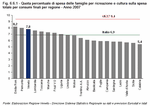
Figure 6.6.2
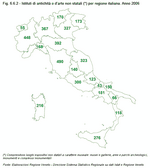
Figure 6.6.3
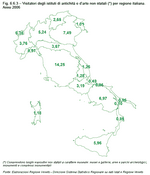
Figure 6.6.4
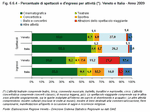
Figure 6.6.5

Figure 6.6.6
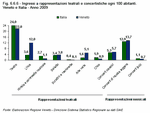
Figure 6.6.7

Figure 6.6.8
